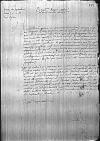List #301
Ioannes DANTISCUS do Sigismund I JagiellonGranada, 1526-09-01
Rękopiśmienne podstawy źródłowe:
Pomocnicze podstawy źródłowe:
Publikacje:
| ||||||||||||||||||||||||||||
Tekst + aparat krytyczny + komentarzZwykły tekstTekst + komentarzTekst + aparat krytyczny
Serenissimae Regiae Maiestati Poloniae etc. Domino et domino meo clementissimo
Serenissima Regia Maiestas et Domine, Domine clementissime. Humillimam perpetuae meae servitutis commendationem.
cf.
Datae
Serenissimae Regiae Maiestatis Vestrae humillimus servus
[1 ] For patria Dantiscus probably means a
